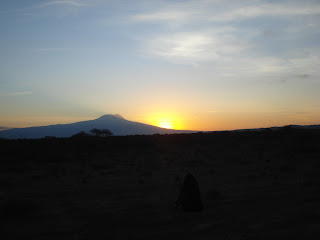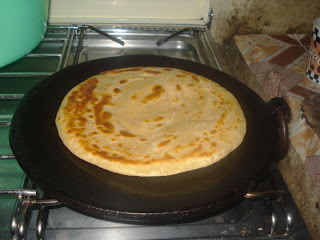On December 10th, SIT Kenya officially turned us loose. We had finished our presentations, left the coast, returned to Nairobi, and packed our bags. Most of the twenty-six students boarded the Jazz Quartet one last time on a mass exodus to the airport. But some of us stayed.
I went with three other girls to Jinja, Uganda, for our final days in Africa. After saying goodbye to the rest of our group, we headed to the route 111 matatu stage to travel to downtown Nairobi.
This is a matatu:
These minibuses fit fourteen passengers, the driver, and the matatu manager. They are the primary and quickest form of transportation in Nairobi. If you were dying and desperately need to get to a hospital, forget ambulances, take a matatu. The drivers make up their own rules for the road, usually creating a third lane if traffic is bad. This elusive third lane can be found between the other lanes of traffic or on the side walk. Matatus also don’t have seat belts. Mostly what keeps you stable is the limited amount of room between you and the person seated next to you. Remember the matatu description; it will be important later on the road to Jinja.
The day before we had discovered that the EasyCoach bus to the Kenya/Uganda border town of Busia was completely full. Luckily, two of the other girls had lived in Kisumu, a city in western Kenya, for their ISP month and knew how to get to Busia from there. This is why we were headed downtown, to catch the 2:30 shuttle to Kisumu. However, we didn’t take the holiday season rate into account and ended up paying double what we had planned. It didn’t matter though, we were on our way.
The shuttle from Nairobi to Kisumu takes approximately seven hours, which seemed fine to me. I was thinking of the roomy airport shuttles or the shuttle buses Gettysburg runs for breaks (you think I would have learned by now). Instead, a matatu with the word “shuttle” painted on it pulls up. You see, the road to Kisumu is bumpy and has more potholes than actual road. Matatus nicely accentuate these road blimps as they do not have shocks. I’m assuming at one point they did, put have probably since fallen off or have been sold as scraps.
To make our matutu even more exciting, it seems we had break issues. Often times while driving up the mountain roads we would have to stop for construction or traffic of some kind. By “stop” I mean we rolled back down the hill until the driver decided to gun it. Three of us were lucky enough to be sitting in the back, giving us a great view of the rapidly approaching stopped cars behind us.
And then the tire popped.
Actually, this was nice. We got to get out of the matatu and walk around. We had pulled over on what looked like a cliff, and there was nothing around. It was quiet, the stars were pretty, and we could stand out in the middle of the road without worried about getting hit by another matatu.
Once the tired was replaced, we continued to Kisumu. We only rolled backwards once more and managed to get to the New Victoria, our hotel for the night, by 11:30. Only nine hours later.
 |
| Tuk Tuks- Kind of like a motorized rickshaw |
An hour and a half into the trip, the bus broke down. Of course, the passengers didn’t need to know that. The driver just got off the bus and walked away. The four of us got off the bus twenty minutes later to look for the driver. We found her under a tree chewing sugar cane and she promised the repair piece would be there in a half hour.
 |
| Piki piki- you sit on the back |
From the bus stop, we sat on the backs of these cushioned bikes and rode to the boarder. Once across the border, we got on another matatu destined for Jinja. We waited an hour for it to be stuffed to capacity and took off for yet another four hour bumpy drive.
Then that matutu broke down.
But it was only for a moment. They just pushed it until the engine caught.
Once in Jinja, we took piki pikis to the camp site. This is easily my favorite from of transportation in Kenya. As you saw above, a piki piki is just a motorbike, known as a boda in Uganda. When ride one, you sit on the back, except we didn’t know that “proper ladies” sit sideways. How the proper ladies don’t fall off is beyond me.
And then we got to the camp site. It had little dorms overlooking the Nile and was crazy pretty. And, oddly enough, the guy from New Zealand who was at the last hostel I stayed at (see last post) was there too. AND THEN we found the SIT Uganda kids, which included Emily, the girl I interned at DC Central Kitchens with over the summer. Small world.
The next day we left at 8:30 to raft the Nile. No biggie.
Actually, it was terrifying. Or at least the first time we flipped in a rapid it was. Four million things race through your mind, some of which include crocodiles, rocks, never breaking the surface, wondering where your paddle went, hoping you don’t end up under the boat, how much water is going up your nose, and the whole life flashing before your eyes thing. After the first flip, it’s a lot of fun. Though I drank way more Nile water than anyone really needs to.
The following day was two days before in reverse. We piki pikied back to the matatu stage and matatued back to Busia. This time the matatu didn’t break down, but we did lose a window on the way. It just fell off.
From Busia we actually got to get on the EasyCoach bus this time. Only it wasn’t much better than a matatu. It had more space to stretch out, but still didn’t sleep.
And now I am writing to you from the Nairobi airport, going on 36 hours with no sleep. If I don’t sleep on my flight from here to Amsterdam, I can beat jetlag. But that won’t happen.
Though seeing, swimming in, and drinking the Nile made the entire trip and lack of sleep soooooo worth it.
This is not my last post. One more to come. Stay tuned to find out what leaving Kenya is like.






















































